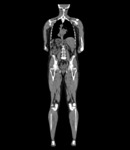Purpose
The amount and anatomical distribution of fat and muscle at L3 vertebra level is an important prognostic factor in various diseases[1-3]. Although this information is contained in CT scans, it is hard to quantify in clinical routine because manual segmentation is time consuming. The purpose of this study is to investigate the feasibility of a deep learning-based method for fully automatic segmentation of subcutaneous fat, visceral fat, psoas muscle, abdominal muscle and long spine muscles at L3 level.
Methods and materials
150 native full body CTs were used (120 kVp, 5 – 200 mAs, in-plane resolution 0.86 – 1.03 mm, resampled to 5 mm slices). Trained observers defined the reference standard by manual annotation of subcutaneous fat, visceral fat, psoas muscle, abdominal muscle and long spine muscles at L3 level. 100 images were used to train two convolutional neural networks: the first network detects the L3 slice from the 3D volume and the second network segments the 5 tissue classes in the detected slice. The remaining...
Results
The median distance between the manual and automatic slice selections was 2.21 slices (11 mm). The average Dice coefficients over the 50 test images were: 0.96 ± 0.02 for subcutaneous fat, 0.82 ± 0.09 for visceral fat, 0.85 ± 0.06 for psoas muscle, 0.89 ± 0.05 for abdominal muscle, and 0.91 ± 0.03 for long spine muscles.
Conclusion
The results show that accurate quantification of body composition in CT is feasible without human input.
Personal information and conflict of interest
P. Moeskops; Utrecht/NL - Employee at Quantib-U BV W. B. Veldhuis; Utrecht/NL - Founder at Quantib-U BV I. Isgum; Amsterdam/NL - Founder at Quantib-U BV B. de Vos; Amsterdam/NL - Founder at Quantib-U BV P. A. de Jong; Utrecht/NL - nothing to disclose T. Leiner; Utrecht/NL - Founder at Quantib-U BV
References
1. Neeland et al. "Visceral and ectopic fat, atherosclerosis, and cardiometabolic disease: a position statement." The Lancet Diabetes & Endocrinology (2019).
2. Gibson et al. "The role of computed tomography in evaluating body composition and the influence of reduced muscle mass on clinical outcome in abdominal malignancy: a systematic review." European journal of clinical nutrition (2015).
3.Engelke, Klaus, et al. "Quantitative analysis of skeletal muscle by computed tomography imaging—State of the art."Journal of orthopaedic translation15 (2018): 91-103.




